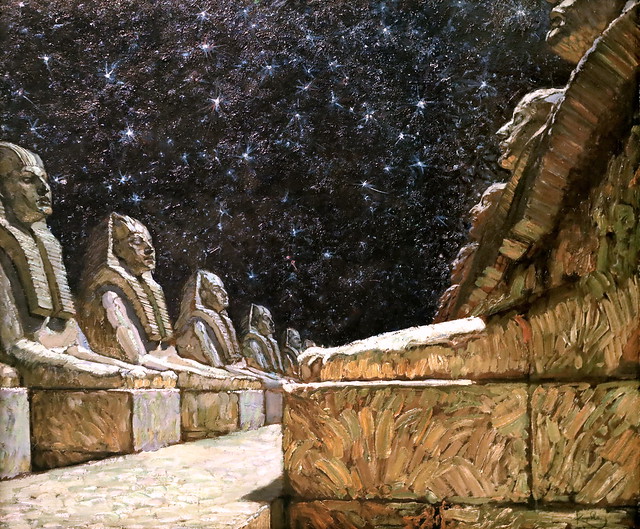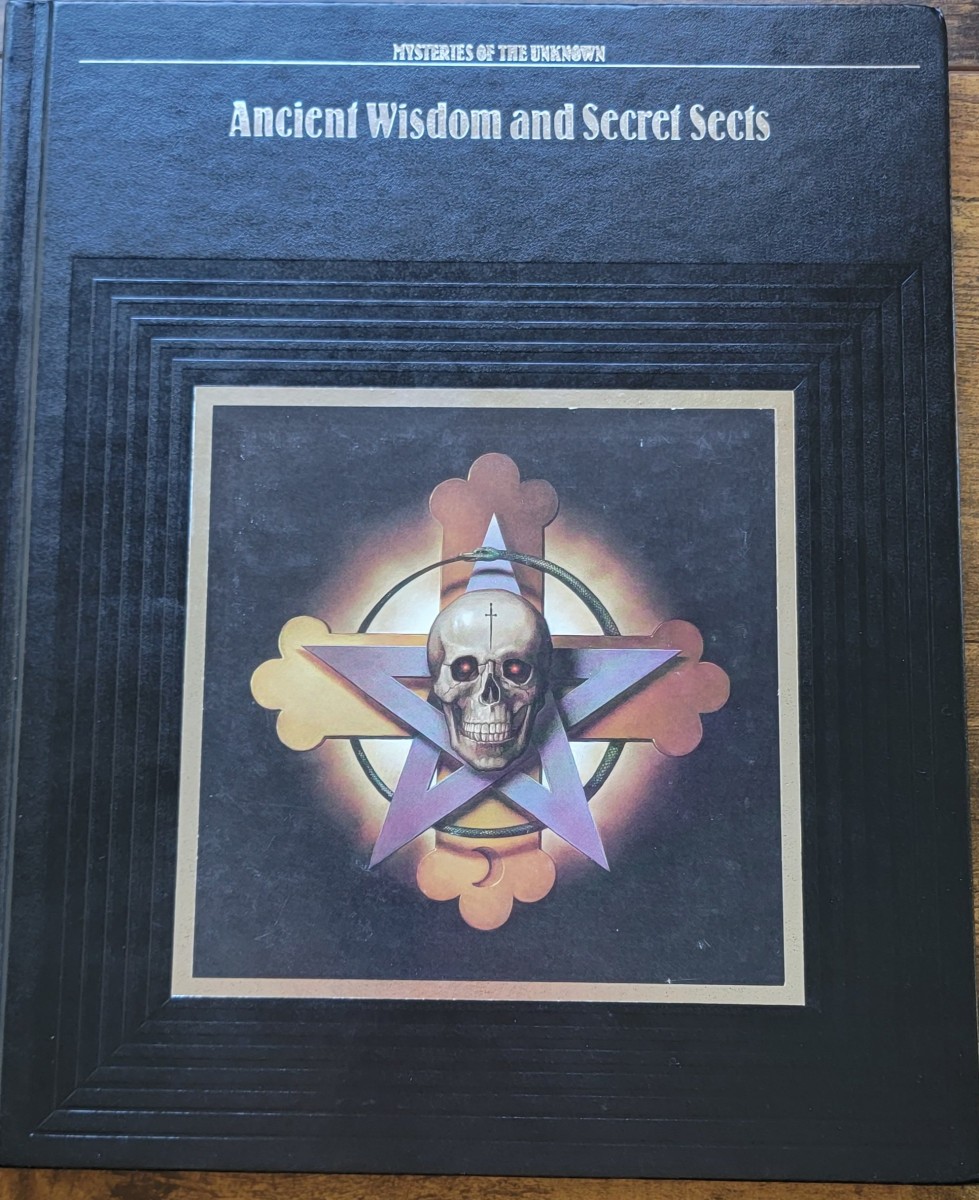I am a child of the ’80s. Thirty years ago is a long time in itself but considering the advancement in technology it might as well be 100 years. When we wanted to know something we had to go to the library or head over to a rich friend’s house who could afford the Encyclopedia Brittanica. I didn’t have any rich friends and the library was outside of my allowed bicycling range. Therefore the answers to my questions were to simply forget the question.
Knowledge was in books then, there were no omnipresent AI like my Google Home that will just tell me the answer. And so with my method of forgetting the question I believe a certain amount of curiosity was suppressed as a result. Why be curious when it is too difficult to find the answer?
This is where books like Mysteries of the Unknown come in. These held the answers to questions that no teacher could really give us information on and a librarian might call the school psychologist if inquired about. Aliens, cults, psychic voyages, the good stuff that every kid wonders about but are all afraid to ask! I asked my parents for these books and surprisingly they said yes! Like the household cable my dad eventually cancelled the subscription without warning before I got the complete set but I had more than enough to be content.
Thinking back I cannot remember reading these books and so they must have not had much of an impression except for a few of the pictures. They sat on my shelves then in boxes for thirty years until I rediscovered them and brought them home with me.
This one, “Ancient Wisdom and Secret Sects,” is the first one I’ve read since the 1980s. I now realize that everything in this book would have seemed so bizarre to me, so fantastical and mysterious. However, reading it now after a lifetime of travel and study I’m left somewhat disappointed. I was hoping to find some new knowledge, something that gives me the feeling of being in a Dan Brown novel. I want to know exactly what the Illuminati has done and continues to do to change the world as well as who its members are. I want to be behind the curtain.
Instead, reading this book gives me the belief that these cults are nothing more one or a combination of the following: boy’s clubs, charlatans, mentally ill, or at in a better light, groups driven to secrecy by persecution. At my age, I know that secret societies abound yet the one controlling things are that 1% currently meeting in Davos who are planning the way the world works for the rest of the 99%. Be rich, be greedy but give everyone just enough so they don’t rise in revolution. This is the world and to be in the club that matters you just need to be obscenely wealthy.
That really is too bad. I was hoping for more mysticism, more magic when it really counted. I still believe in much of the unseen, call it what you will, but the majority of groups presented in the book I find to be Hocus Pocus.
In any case, I enjoyed the read and here are my notes:
A number of the mystery religions had origins in fertility cults or grew out of local agricultural festivals. One of these was the cult of Eleusis, which flourished in Greece from about the sixth century BC until about AD 395. Centered west of Athens in the town of Eleusis, the sect honored Demeter, goddess of grain, and her daughter, Persephone. According to Greek mythology, young Persephone was abducted and forced to marry Hades, lord of the underworld. To reclaim her daughter, Demeter prevailed upon Zeus, king of the gods, to intervene. Zeus persuaded Hades to allow Persephone to live on earth eight months of the year, a period suggesting the growing season. For cult followers, Persephone symbolically died each year with the harvest, and her goddess mother created winter from grief. Persephone was reborn each spring with the new crop, and Demeter rejoiced by making the land fruitful again. This allegory of death and resurrection was the basis for the initiates’ hope of eternal life.
Across all religions and cultures in the northern hemisphere we see the same thing. Life returning after the spring equinox (Easter etc) and then death at winter. It all revolves around the harvest. Religion is tied to the sun which allows to the crops to grow and life to carry on. Christianity just incorporates that into a man and changes the sun into a halo.
There were parallels between Mithraism and Christianity, and the two religions competed for dominance in the Roman Empire. The setting and rising of the sun, symbol of the sun god Mithra, recalled Christ’s death and resurrection. Moreover, the Mithraic festival in celebration of the sun god’s birth was held on December 25, recognized as Jesus’ birthday.
Confirmation of the importance of the sun in regards to religion.
Celts were said to celebrate the winter solstice on December 25th.
Indeed, Christmas! Christians do not like to recognize the connection as they prefer a literal version of Jesus and his birthday even when the church itself admits nobody knows the date of his actual birth. It is amazing to see how they shut out completely the fact that Jesus’s birthday was placed on December 25th in an attempt to supplant the solstice which most tribes had been celebrating for millennia.
Lying on a mosaic floor that symbolizes good and evil is a drawing of a Euclidian theorem essential to geometric calculations in architecture. To Masons, it signifies a love of art and science.
Not being a Mason myself I wonder where their true beliefs lie in regards to religion. From what I understand a Mason must believe in a supreme being. What I cannot reconcile is that usually religion and science are in conflict with each other. So how can Masonry love art and science yet demand that belief in a supreme being is mandatory?
I did consider joining once and met with a few members but then went to Japan instead. Twenty years later here I am wondering about them. I still have interest but through my own travels and learning have been let down by so much I had previously thought was true. Also, I find it hard to believe the Masons which I have met with all their Masonry secrets would know more than I do from my travel and study. I see them blinded by the same propaganda, same religions, same belief structures as everyone else give the location, they just belong to a secret club, or society with secrets as they prefer to say.
To the uninitiated, their work seemed holy. Since ancient Egypt, large stone edifices have been monuments to power, celebrating the magic of priests or the divine right of kings. As outsiders watched, men – some armed with chisels and mallets, others with compasses, rulers and squares – made temples grow from the ground.
Yes and this holds true today. Go to the pyramids, to Ankor Wat, to New York or Tokyo and be fascinated. I couldn’t build the most rudimentary mud hut yet I can soar 100 floors up in an elevator in a building that appears made of glass. This is magic indeed.
Paradoxically, the Masonic message that so enticed the privileged ranks was one of universal brotherhood – the value of each man, regardless of his given social lot.
I like this message. The message of the world today is grab as much as you can at the expense of everyone else. A message of brotherhood is sorely needed as the message of capitalism drives us apart. Much of the world finds this unity for an hour at the local church on Sunday. Unified under the grace of God for an hour and separated by both physical distance and social class by vehicles of vastly different quality. Perhaps there is a poem in there somewhere: The first class confessional in the Lexus SUV or do we get the third rate absolution in the Toyota Camry. I’ll have to give that some thought.
*Side note: Just thinking of a possible poem based on this I’m thinking about the philosophical idea asking if thoughts come from inherently from ourselves or do we pluck them out of an invisible knowledge stream. Some can reach further and deeper into that stream than others making them appear to be geniuses.
When the Masons explored these links, real or imagined, to occult groups of the distant past, it was as part of a larger search for truth. The late seventeenth and eighteenth centuries saw the flowering of the Enlightenment, that radiant epoch when unquestioning religious dogma was eclipsed by the belief in human reason and perfectibility.
I applaud the Masons for these noble aims, to get out of the thumb of superstition and fear of the church. But I suspect they could not break with its ideas completely for the sake of their members. Religious belief is not easily shaken off so probably better for their membership.
What Weishaupt sought, George Johnson has written, was “a world where the divisions of class, religion, and a nation were overcome and all people were united in a universal brotherhood. Like the French philosopher Rousseau, Weishaupt envisioned a day when mankind would regain a natural sense of equality and happiness, uncorrupted by organized religion and class distinctions.
I would join tomorrow. I’ve always considered myself a “global citizen” but in my mature years understand how naive it is. The world is always pulling you back in demanding you identify as they do whether it be national alliance, religious affiliation, political preference and so on. Humans are tribal; we’re not improving but indeed seem to be sliding backwards.
French composer Erik Satie, whose measured, haunting melodies are still loved today, drew inspiration from study of the Cabala.
I love Erik Satie. I first learned of him when referenced from a character played by Anthony Hopkins although I cannot recall the movie. I always wanted to be as intelligent and refined as many of Sir Hopkin’s characters and indeed Sir Anthony Hopkins himself. I then listened to the music and was entranced by Satie, especially Gnossienne No. 4 which is hauntingly melancholy. It makes me think of being a small room all by myself in the countryside of France. Everyone I know is dead and I am just an old man in a wooden rocking chair watching flickering shadows of the past on a white wall while waiting to die.
The so-called Celtic Revival, which led eventually to formation of the independent Republic of Ireland and the rise of Scottish nationalism, depended in the early days on writers, Yeats among them, who gave shape and credence to the idea of an Irish nation or a Scottish nation. These spinners of national myth reached deep into Celtic folklore and came up with occult elements – witchcraft and fairies and secret Druidic wisdom – that distinguished their peoples and gave political leaders traditions to pull on.
I do not know the history of Ireland or how the Republic came to be. This passage awoke a huge gap in my knowledge and so now I find myself listening to Dan Carlin’s “The Celtic Holocaust,” in his Hardcore History series as well as watching Rome on Netflix. To understand the past you must start from the beginning.

